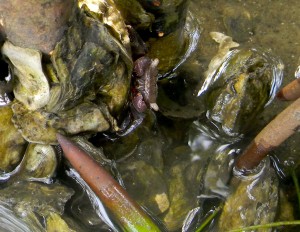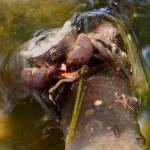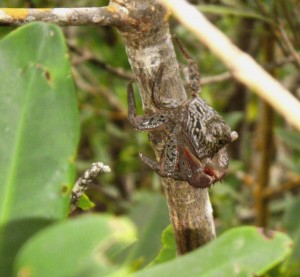by Megan Riley
As adults, mangrove tree crabs (Aratus pisonii) tend to forage on fresh mangrove leaves in the canopy. As omnivores, they will also prey on nitrogen-rich insects, larvae, and even juveniles of their own species. However, it’s unclear how these organisms balance their nitrogen requirements and other nutritional demands. This summer I have focused my research on addressing this question. Specifically, I am investigating how their diet choices affect their overall health and ability to reproduce.
In order to perform this research, I first have to catch the Aratus! Despite the abundance of these animals in mangrove stands on the Indian River Lagoon, tree crab hunting is a tricky business. Over the course of the summer, I’ve learned a number of tips for trapping the elusive crustacean…
1. High tide is the best time to look for Aratus because it is when they are the most active in the canopy and branches overhanging the water. At low tide, the adult crabs often descend to scavenge for food on lower branches, prop roots, and sometimes even the sediment floor. The complexity of the prop roots as well as the community of encrusting organisms (oysters, tunicates, sponges, etc.) that cover them provide ample refuge for startled crabs and make them difficult to spot.
2. Aratus are most often visible on red mangrove stands close to the water’s edge. Mangrove tree crabs are semiterrestrial, so they are able to spend the majority of their time on land, but they must still immerse themselves in water regularly to maintain a thin film of moisture on their gills. Additionally, Aratus are linked to the water for reproduction. Females release eggs into the water, which undergo a planktonic larval stage before settling back into mangrove habitats as juveniles. As a result, mangroves close to the water’s edge are prime real estate for these crabs!

Mangrove tree crab seeking refuge in the oyster-covered prop roots of a red mangrove at low tide. (Megan Riley)
4. Mangrove tree crabs employ several very successful mechanisms to evade their natural predators, which include birds, fishes and other crabs on the sediment surface. These predator evasion techniques also allow them to elude people! For example, Aratus are able to escape predators in the water and on the forest floor by scurrying up the trunk and climbing far into the canopy. To escape any threats that they encounter in the canopy, Aratus quickly abandon ship, jumping from branches into the water below and hiding amongst the prop roots and oysters at the base of the tree. Luckily, we can take advantage of this behavior while trying to capture Aratus by placing a net or small bucket beneath the branch that an Aratus is on, and quickly scooping the crab off the branch and into the bucket. Even if the Aratus moves too quickly and we miss it, the crab will often jump off the branch and land right in our bucket to come back to lab with us.
-Megan Riley is a PhD student at the University of South Carolina. She is spending the summer studying Florida mangroves with the team from the Smithsonian Environmental Research Center and the University of Maryland.
More stories from the mangroves >>
This material is based upon work supported by the National Science Foundation under Grant Number 1065098. Any opinions, findings, and conclusions or recommendations expressed in this material are those of the author(s) and do not necessarily reflect the views of the National Science Foundation.



